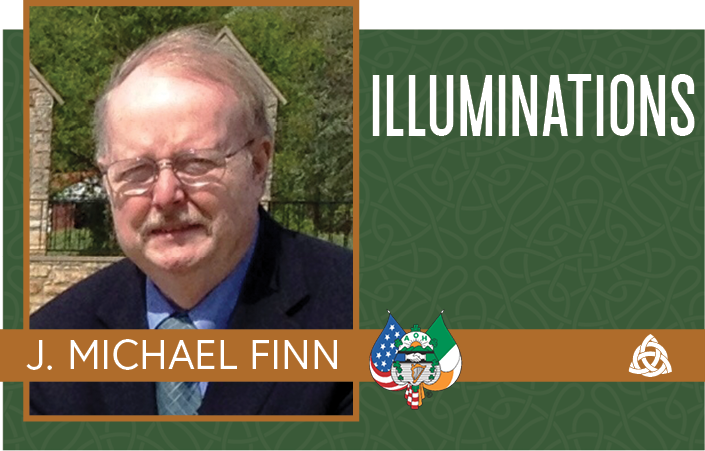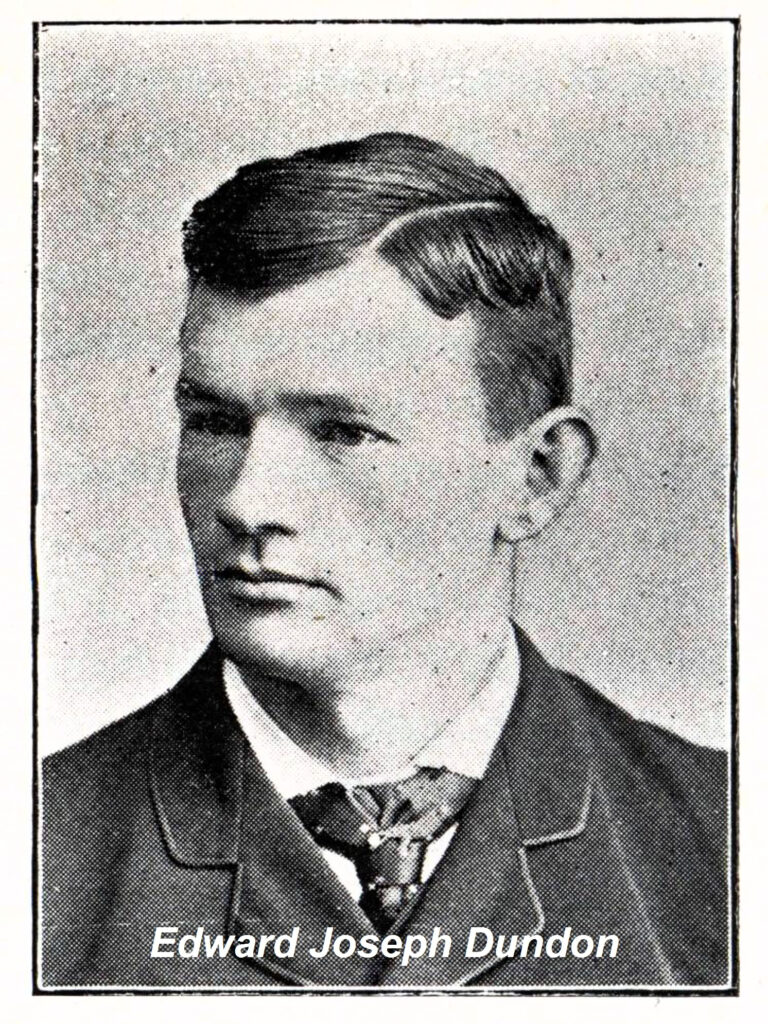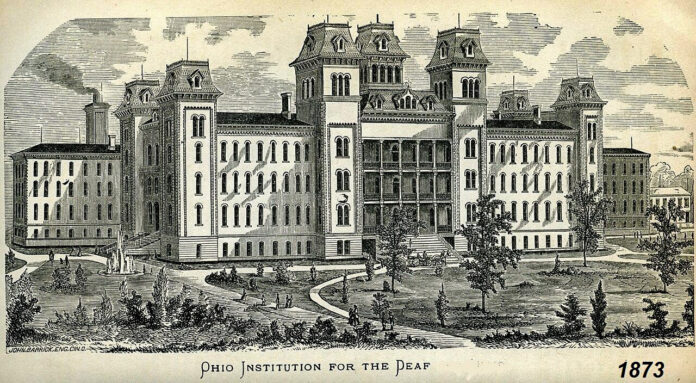
Baseball’s First Deaf Player
By Mike Finn
Well, I beat the drum and hold the phone
The sun came out todaY
We’re born again, there’s new grass on the fieldA-roundin’ third and headed for home
It’s a brown-eyed handsome man
Anyone can understand the way I feel.
– John Fogarty
Edward Joseph Dundon was born on July 10, 1859, in Columbus, Ohio, to Irish immigrants John and Mary Dundon. John supported his family as a laborer.

Although John and Mary did not suffer from hearing loss, their children Edward, Mary and Ellen were born deaf. Edward, Mary, and Ellen grew up in Columbus and lived at the Ohio Institution for the Deaf (later the Ohio School for the Deaf) during the school year.
Edward entered the school in September 1868 at age nine and was there well into his twenties. Mary entered the school the same year. Ellen was younger and did not enter the school until 1875.
The Dundons left Ireland around 1855, after having their first child in 1854. They would have ten others through 1872, Edward being the fourth.
The Ohio School for the Deaf
The Ohio School for the Deaf was established in 1829 by an act of the Ohio Legislature. It was the first deaf school in the US that was 100% funded by the state.
The school opened in a rented building on the corner of Broad and High Streets. In 1834, a permanent school was completed on East Town Street, now site of the Topiary Garden, Deaf School Park and Cristo Rey Columbus High School.
Besides the normal education courses, the school also taught the students a trade. Edward Dundon studied book binding and graduated as class valedictorian in 1878.
United States First Deaf Baseball Program
The Ohio Institute was also the first residential secondary school in the United States to incorporate a baseball program. The school’s shoemaking teacher, Parley P. Pratt (1839-1915), began training the boys during the 1870s, and Edward Dundon signed on as the pitcher. Pratt served as the baseball coach throughout Dundon’s tenure at the school.
The school produced several deaf ball players who went on to fame. Among Dundon’s classmates were deaf major league players John Ryn, from Marion, Ohio and William Hoy from Houcktown, Ohio.
The institute had a strong baseball program during the 1870s and 1880s. Pratt developed his team to the point that it embarked on a statewide tour in 1879. Billed as the Ohio Independents, the team logged many miles traveling throughout the state and beyond. They racked up an impressive 44-7 record.
The Independents faced major league teams in Cincinnati, Cleveland and Syracuse. They performed extremely well, posting a 6-2 record against the major league clubs. Edward Dundon became the star pitcher of the team. The Independents included one hearing player to insure that the other team didn’t cheat.
Dundon, a right-hander, was big for the era, 6 feet tall and 170 pounds. As he grew older, he joined local amateur and semi-pro clubs during the summer breaks, playing with hearing teammates. Dundon returned to the school in the winter after the baseball season ended and worked there utilizing his book binding trade.

In 1882, Dundon played for the local independent Columbus Buckeyes. After a successful first year in 1882, the American Association expanded to add two teams, New York and Columbus. The Buckeyes reorganized and incorporated pros from other association teams while retaining some holdovers from 1882.
In late May 1883, Dundon re-joined the Buckeyes when school let out. Dundon made his major league debut on June 2, 1883, in an 8-6 victory over Philadelphia.
Dundon pitched for the team for two seasons. Thus, in 1883 he became the first deaf-mute player in major league history.He is also credited with developing the silent hand signals still used today in baseball by coaches and catchers.
Since most of the deaf players couldn’t speak, professional baseball players, including Dundon, were often saddled with the inappropriate nickname, “Dummy.” In today’s age, thankfully, a label like that would be totally off-limits.
Dundon headed south in 1885, joining Atlanta with the Southern League. Atlanta won the pennant that year. Dundon posted a 21-11 record with 210 strikeouts and 1.30 ERA in 37 games pitched.
Baseball’s First Deaf Umpire
Alabama. On October 20, 1886, in a game in Mobile, Dundon was called on to umpire.
The game is cited as the first instance of a deaf umpire calling a contest between professional squads. An article in The Sporting News credits Dundon with using hand signals while umpiring, the first such use of hand signals to call a game.
In November 1887, he signed a deal with the Syracuse Stars of the International League. His best batting performance was with Syracuse in 1887 when he got 65 hits in 200 times at bat for an average of .325.
On September 13, 1887, Dundon married Mary Lizzie Woolley from Cincinnati. She was a classmate from the Ohio School for the Deaf, entering the school a year after he did. The couple had one son, Edwin Pius Dundon, born in September 1889, who was not deaf.
Dundon’s oldest brother, Thomas, who was born in 1854 in Askeaton, County Limerick, was a popular Columbus politician. Thomas was very active in the Columbus Irish community and was a member of the Ancient Order of Hibernians. He served as State President for two terms (1888-1890), and was elected as National Treasurer of the AOH for four two-year terms (1890 until 1897).
In April 1889, Edward Dundon joined Evansville of the Central Interstate League. He played with the club through mid-July, when he returned to Columbus. His record stood at 14-8.
He accepted an offer to join a club in Peoria in February 1890. After only two games, he left the club. He retired in May 1890 and returned to Columbus and book binding. His career in baseball was over.
Most listings of Major League deaf players list a total of 19 deaf players, beginning with Edward Dundon in 1879 and ending with Curtis J. Pride, who played from 1993 to 2006. Six of the early deaf players were graduates of the Ohio School for the Deaf. On August 18, 1893, Edward Dundon died in Columbus, Ohio from tuberculosis at the age of 34. His funeral was held at St. Patrick’s Church in Columbus. The Mass celebrant was Rev. Hugh Leonard, O.P. assisted by Rev. John Vallely, O.P. and Rev. Francis Kelly, O.P. Edward Joseph Dundon is buried at Mount Calvary Cemetery in Columbus.







I was saddened to learn of the passing of iIrish columnist J. Michael Finn. I read his well-written articles every month and always learned something new and interesting. He was so knowledgeable about Irish and Irish American history. In 2021 I contacted him about one of his articles and expressed my appreciation for his column. He sent me a gracious, thoughtful response and provided me with some additional information about the topic of the column. He ended his email with words of encouragement to keep researching my family’s Irish history. He will be greatly missed.